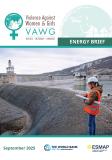Publications
Rapid growth of distributed photovoltaics (DPV) has upended the paradigm of one-way power from the grid. Solar electricity systems located close to consumers empower them to self-supply and feed into the grid. For utilities, the impacts—positive or negative—depend on how DPV is deployed. With good policies, DPV can contribute to reliable grid operation and a financially sound power sector.
This report catalogs nine ways that DPV systems can, with other distributed resources, help people in low- and middle-income countries to: (1) reduce electricity bills; (2) provide least-cost backup (e.g., compared to diesel generators) for consumers facing grid outages; (3) supply least-cost generation to the grid, especially where land is constrained; (4) defer certain transmission and distribution upgrades; (5) ‘bootstrap’ underperforming utilities by improving service and increasing bills collections for consumers in a microgrid; (6) provide ancillary grid services; (7) support low-income communities with subscriptions or connections to medium-large DPV; (8) reduce utility financial losses by supplying consumers in arrears; and/or (9) meet urgent needs following a disaster with a preassembled ‘box’ of PV and batteries. Energy sector decision makers can assess which among these use cases make sense in their local context to inform strategy and program design.
This report is the second in the From Sun to Roof to Grid series.
Lee,Alan David; Dobrotkova,Zuzana; Khanna,Rohit; Pargal,Sheoli; Beek,Torrey Howell; Chavez,Sandra; Flochel,Thomas; Keskes,Tarek; Muller,Simon; Nicolas,Claire Marion; Song,Chong Suk..
From Sun to Roof to Grid: Distributed PV in Energy Sector Strategies (English). From Sun to Roof to Grid Washington, D.C. : World Bank Group. http://documents.worldbank.org/curated/en/532941634543900788/From-Sun-to-Roof-to-Grid-Distributed-PV-in-Energy-Sector-Strategies




